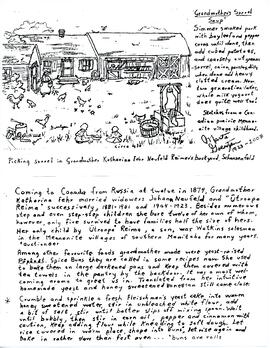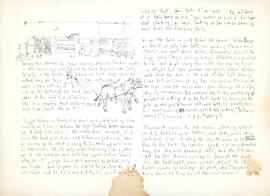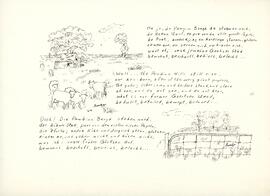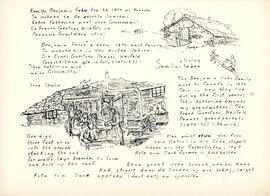- CA MHC PP-6491-21-6491-21-15
- Item
- 1987
Part of Marta Goertzen-Armin fonds
Sketch of a woman and two girls in the yard in front of their housebarn
"Grandmother's Sorrel Soup
Simmer smoked pork with bay leaf and peppercorns until done, then add cubed potatoes and coarsely cut greens - sorrel, onion, parsley, dill. When done add heavy clotted cream. Now, two generations later, whole milk yogurt does quite well too!
Sketches from a Canadian prairie Mennonite village childhood.
Picking sorrel in Grandmother Katharina Fehr Neufeld Reimer's backyard, Schanzenfeld
Coming to Canada from Russia at twelve in 1874, Grandmother Katharina Fehr married widowers John Neufeld and "Ütroopa Reima" successively, 1881-1901 and 1904-1923. Besides numerous step and even step-step children she bore twelve of her own of whom, however, only five survived to have families half the size of hers. Her only child by Ütroopa Reima, a son, was Watkins salesman in the Mennonite villages of southern Manitoba for many years.
Auctioneer
Among other favourite foods grandmother made were yeast-raised Pāpânāt. Spice buns they are called in some recipes now. She used to bake them on large darkened pans and keep them covered with tea towels in the pantry by the backdoor. It was a most welcoming aroma to greet us in. Translated from her intuitive homemade yeast and honey sweetened one can still come close:
Crumble and sprinkle a fresh Fleischman's yeast cake into warm honey-sweetened water, stir in unbleached white flour, add a bit of salt, stir until batter slips off mixing spoon. Wait until bubbly, then stir in corn oil, pepper, and cinnamon with caution, keep adding flour while kneading to soft dough. Let rise covered in warm place, shape into buns, let rise again and bake in rather slow than fast oven..."
Goertzen-Armin, Marta, 1923-2009















